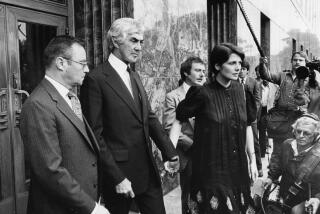Eleanor knockoffs spark a knock-down, drag-out fight
Almost 35 years have passed since a Ford Mustang named Eleanor tore up the streets of the South Bay in the cinematic crash-fest “Gone in 60 Seconds.”
The crudely crafted indie flick found a cult audience and inspired a 2000 big-budget sequel starring Nicolas Cage, Angelina Jolie and, of course, a vintage Mustang named Eleanor.
FOR THE RECORD:
Gone in 60 Seconds: A Business article Saturday about litigation involving the 2000 movie “Gone in 60 Seconds” referred to the film as a sequel to the 1974 movie of the same name. The 2000 movie was a remake. —
It also spawned the legal equivalent of a 10-car pileup that involves, among others, automotive legend Carroll Shelby and Denice Shakarian Halicki, widow of the original “Gone in 60 Seconds” director H.B. “Toby” Halicki.
Halicki, who accuses Shelby of working with a Texas company to produce unauthorized Eleanor knockoffs, claims in lawsuits that the modern-day Eleanors violate copyrights she owns.
“We believe there are many millions of dollars at stake here,” says Beverly Hills attorney Allan Browne, who is representing Halicki, a 51-year-old Los Angeles resident.
The 85-year-old Shelby, who has homes in Bel-Air, Las Vegas and his native East Texas, denies wrongdoing, claiming he obtained the trademark rights to use the Eleanor name on cars in a 2002 filing with the U.S. Patent and Trademark Office.
“From Shelby’s point of view, all he did was use his legally recognized rights to license someone else to build these cars,” says M. Neil Cummings, a Los Angeles attorney who represents Shelby.
The 1974 “Gone in 60 Seconds” is a touchstone for connoisseurs of the car-crash genre. The tale of a car thief’s quest to steal 48 four-wheel gems in a few days’ time, it features 93 car crashes during a single 40-minute chase scene and includes hair-raising footage shot on the Harbor Freeway and the streets of Long Beach, Torrance, Carson and other south Los Angeles County cities. The star car is Eleanor, a bright yellow souped-up Mustang of early ‘70s vintage that is pinched from the parking garage of the International Tower in Long Beach.
Called “a genuine primitive work of art” by a Times film critic, the movie became an unlikely box-office hit, pulling in a claimed $40 million -- more than $150 million in today’s dollars.
H.B. “Toby” Halicki, who not only directed but also starred in the movie, died in 1989 when a stunt went awry during the filming of “Gone in 60 Seconds: 2.” He had married Denice, a former model, only three months before. He left behind a multimillion-dollar estate that kept his widow and brothers fighting in court for years.
In 1995, Denice Shakarian Halicki struck a deal with Walt Disney Co.’s Hollywood Pictures for the remake of “Gone in 60 Seconds,” which grossed $237 million worldwide. This time out, Eleanor was a silver-gray Mustang described by the car thieves as a 1967 Shelby GT500.
As for Carroll Shelby, he first made his name on the track, winning the 24 Hours of Le Mans race in 1959 and competing in eight Grand Prix races. It was his career as a designer in the 1960s that made him a legend with the supercharger set. He produced a string of highly powered vehicles, including the famed Shelby Cobra and the Mustang-based Shelby GT500.
Original ‘60s-era Shelbys in pristine condition are worth hundreds of thousands of dollars. And Ford added a GT500 to its new Mustang lineup when it revived the long-running marque with a retro redesign.
Over the years, Shelby has been involved in a variety of licensing deals, including one in 2002 with Unique Performance, a vehicle customizer based in the Dallas suburb of Farmers Branch. Unique Performance began re-creating 1960s-style Shelby Mustangs using the bodies of old “donor” Mustangs and charging buyers $119,000 to $214,000 per car.
Unique Performance eventually collapsed under the weight of a criminal investigation and complaints from customers, who accused the company of taking in millions of dollars in deposits for which no cars were delivered. The company is in Chapter 7 bankruptcy liquidation, and law enforcement officials said a Dallas County grand jury was expected to consider the criminal case within a few weeks. Attempts to reach Unique Performance were unsuccessful; the company’s phone has been disconnected.
Shelby, named as a defendant in some of the civil suits filed by Unique Performance’s customers, terminated his licensing agreement with the company last year.
One of the cars marketed by Unique Performance was a replica Shelby GT500 based on the car from the “Gone in 60 Seconds” sequel. Halicki sued Shelby and Unique Performance in federal court in 2004, claiming the replicas violated her exclusive rights to the Eleanor Mustang.
A judge threw Halicki’s lawsuit out, ruling that because Disney held the rights to the car used in the sequel, it was the only party that could sue to protect them.
In his ruling, the judge noted that Shelby had obtained a trademark to use the Eleanor name on cars, while Halicki didn’t apply for a trademark on the name until several months after filing suit. The judge also said that the Shelby Mustang in the sequel differed substantially from the yellow fastback used in the original film.
Halicki is appealing that ruling. And she filed another lawsuit in federal court against Shelby and Unique Performance last October. The new suit incorporates details of the Texas company’s financial and legal woes and accuses the defendants of causing Eleanor to be associated in the public mind “with potential criminals.”
Halicki is seeking damages from Shelby, Unique Performance and its former executives and wants the court to revoke Shelby’s Eleanor trademark.
Meanwhile, Halicki struck a deal with Disney in which the company states that it doesn’t own the merchandising rights to the Eleanor Mustang. That agreement, Halicki’s lawyers contend, gives her exclusive rights to vehicles named Eleanor -- no matter what they look like.
“It doesn’t matter if it was a bus called Eleanor,” Browne says. “The magic was the name, and that was the thing [Shelby] tried to get.”
While the case grinds on toward a November trial date, Halicki is pursuing her own Eleanor business venture, partnering with an Oklahoma company to custom build Mustangs resembling the 1967 car from the sequel. It will come in two versions: a 535-horsepower model priced at $139,000 and a 770-horsepower model priced at $189,000.
To author and auto historian Wallace Wyss, the legal wrangling might have been avoided if the producers of the sequel hadn’t used the E-word.
“This whole lawsuit probably wouldn’t exist,” Wyss said, “if they had just called the car Jane.”
More to Read
Inside the business of entertainment
The Wide Shot brings you news, analysis and insights on everything from streaming wars to production — and what it all means for the future.
You may occasionally receive promotional content from the Los Angeles Times.










